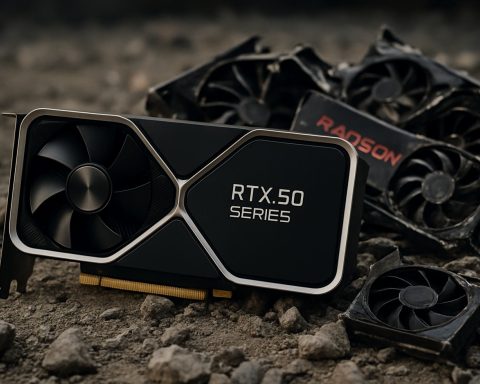- Windows 11 Insider’s Canary channel reveals a significant performance issue affecting Nvidia GPUs, primarily linked to incompatibility with DirectX 9.
- This bug disrupts applications, causing crashes in games and standard software like PowerPoint, sparking frustration among testers.
- Microsoft is aware of the issue and it’s on their list of known problems for build 27808, though no official fix is implemented yet.
- Advanced users have managed a temporary solution by replacing D3D9 DLL files, although it’s complex and requires disabling the Nvidia GPU.
- This issue mainly impacts tech enthusiasts, offering a preview of potential hiccups before a broader public release.
- The ongoing challenge stresses the importance of collaboration between Microsoft and its community for future updates and fixes.
Windows 11, the latest flagship operating system from technology titan Microsoft, stands at the crossroads of innovation and frustration. Users participating in the Windows Insider program, specifically those testing the edgy waters of the Canary channel, are sounding the alarm over a significant hitch impacting Nvidia GPU performance. The heart of the issue is an incompatibility with DirectX 9, an older visual rendering library, causing chaos for applications across the board.
Imagine trying to launch your favorite game or present a well-polished PowerPoint, only to be met with crashing programs and unresponsive screens. This is the current reality for some of the most adventurous tech enthusiasts, who often embrace the risks in exchange for a glimpse into future Microsoft innovations. Yet this time, the thrill comes at the cost of disrupted workflows and an air of uncertainty as even something as routine as browsing can be affected.
Microsoft has recognized the problem and added it to their ever-evolving list of issues for build 27808, but acknowledgement is just the first step. The intricacies lie within the interactions between Windows 11, its graphical components, and how it communicates with Nvidia’s powerful graphics processors.
For now, some users have taken the fix into their own hands, channeling their inner tech sleuths and navigating the complex terrain of system files. By replacing D3D9 DLL files in crucial directories, skilled users waging battle armed only with administrative access and a copy of PowerShell have found temporary respite. However, this solution requires deactivating the Nvidia GPU first—a cumbersome process that may not be for the faint-hearted or technically unprepared.
The glimmer of good news? This disturbance is largely contained within the confines of the enthusiast community—a testing ground where glitches are not uncommon, but rather a stepping stone to smoother public releases. Despite Nvidia not being directly implicated by Microsoft, the correlation is clear: Nvidia GPUs are the common thread binding the experiences of these vexed users.
The future of this predicament remains uncertain, hinging on the agility of Microsoft’s response and the collaborative feedback loop between the tech giant and its dedicated user base. Meanwhile, the digital landscape eagerly awaits the day when the pioneering spirit is met with seamless functionality—a testament to the resilient yet evolving relationship between users, their devices, and the relentless march of technological progress.
Unraveling the Windows 11-Nvidia GPU Dilemma: Solutions, Insights, and Future Outlook
Windows 11 and Nvidia GPUs: What You Need to Know
Windows 11, Microsoft’s latest operating system, has garnered both excitement and frustration since its release. The Windows Insider Program’s Canary channel recently highlighted a hiccup involving DirectX 9 incompatibilities with Nvidia GPUs, leading to performance hiccups across various applications. As power users test these beta builds, this conflict proves to be more than a minor annoyance—it’s a significant impediment to productivity and gaming performance.
Understanding the DirectX 9 Incompatibility
DirectX 9, though older, is still widely utilized in many applications and games. The core issue arises when this library doesn’t mesh well with the updated architecture of Windows 11, specifically when run with Nvidia GPUs. The symptoms include crashes, screen freezes, and considerable lag, impacting tasks from gaming to basic presentations.
How-To: Mitigating the Current Issues
For those eager to continue testing new Windows 11 features without being sidelined by these issues, here are practical steps you can take:
1. Rollback to a Stable Version: Consider reverting to a previous Windows build where the issue wasn’t present. Access Windows Settings > Update & Security > Recovery and choose to go back to a previous version.
2. Temporary DIY Fix: For tech enthusiasts, replacing the D3D9 DLL files has proven effective. Use caution as this involves system files:
– Navigate to the necessary directories with administrative access.
– Use PowerShell for replacing the DLL files after deactivating the Nvidia GPU in Device Manager.
3. Stay Updated: Ensure all drivers, especially for Nvidia GPUs, are up-to-date with the latest patches from Nvidia’s official site. Visit Nvidia
Exploring the Future of Windows 11 with Nvidia
Microsoft’s ability to address and resolve these issues with timely updates will determine how quickly stability can be restored for these users. The engagement between Microsoft, Nvidia, and their user communities is crucial in smoothing out these problems.
Market Forecasts & Industry Trends
As Windows 11 continues to evolve, it’s clear that software and hardware compatibility issues will temporarily hinder full adoption. However, successful resolution of these glitches will likely lead to increased user trust and market share expansion for Microsoft.
Security & Sustainability
The release and widespread adoption of innovative solutions shouldn’t come at the cost of digital security. Users should remain vigilant regarding system updates and security patches, which will continue to be a focus of Microsoft and Nvidia.
Quick Tips for Seamless Computing
– Backup Regularly: This prevents data loss while navigating unstable builds.
– Participate in Feedback: Active engagement in feedback forums ensures that your issues reach Microsoft.
– Watch for Updates: Keep an eye on Windows and Nvidia release notes for upcoming fixes.
For those not involved in beta testing, patience will be rewarded with optimized, stable releases that have incorporated user feedback.
Conclusion
The Windows 11 and Nvidia DirectX 9 issue underscores the challenges of embracing cutting-edge technology. Although frustrations with software and hardware interactions are not unprecedented, collaborative problem-solving and feedback will ultimately enhance the user experience. Stay informed, stay updated, and make use of community support while navigating these new developments.









